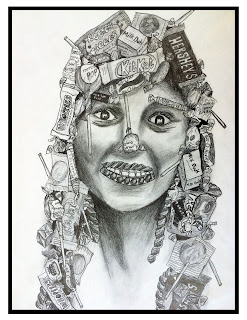He-woman of Art), and myself have created and currently conduct a Portfolio class for Seniors that are seeking entrance into undergraduate studies in Art. We were flabbergasted to discover that hardly any student is prepared to show a portfolio that is worthy of scholarship, and more so of the portfolios that we viewed, NONE of them contained an observational drawing.
So.... It was back to the basics!
I wanted to come up with an observational piece that wasn't so boring for the guys, and keep them interested (especially since they were giving us their valuable social time after school to help better prepare themselves).
So this was the result:
· Buy a butt-load of Halloween Candy
· Get yelled at by my wife for buying a butt-load of Hallowee ncandy
· Take it to school and hide it from the knuckleheads
· Take pictures of each student and blow them up to appropriate size (11x17)
· Have students draw/trace contour lines of their head
· Have students create their faces using observational drawings of Halloween candy
· See the result
I have to admit that I was a bit concerned with what the turnout would be, (as was Ms. Wells, The She-Master of Art, Divine Creator of the Art Universe, Smack Salvador Dali in the face and get away with it because she is so awesome in art), because we believed that this might be a bit advanced for them. But we gave it a go anyway. I wanted to share the results. The lesson that I learned was:
"Never be afraid to push your guys beyond what you may feel is their "scope." They may produce some pretty good mouthwash!" - A Wise, Wise Profit - My mom, Circa. 1988.
Check out some examples!
Senior Student
Senior Student
Senior Student
The Ragster (Student Example)













